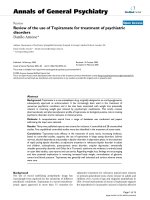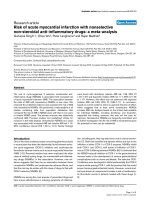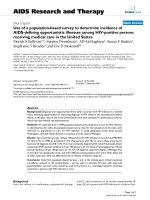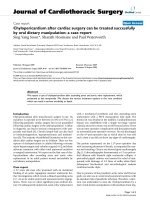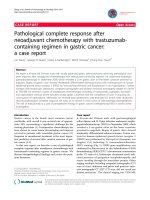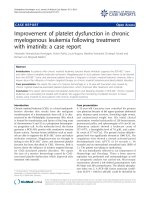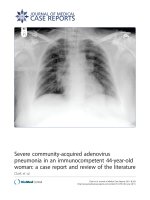Báo cáo y học: " Use of the novel hemostatic textile Stasilon® to arrest refractory retroperitoneal hemorrhage: a case report" pps
Bạn đang xem bản rút gọn của tài liệu. Xem và tải ngay bản đầy đủ của tài liệu tại đây (355.97 KB, 5 trang )
CAS E REP O R T Open Access
Use of the novel hemostatic textile Stasilon® to
arrest refractory retroperitoneal hemorrhage: a
case report
Preston B Rich
*
, Christelle Douillet, Valorie Buchholz, David W Overby, Samuel W Jones, Bruce A Cairns
Abstract
Introduction: Stasilon® is a novel hemostatic woven textile composed of allergen-free fibers of continuous
filament fiberglass and bamboo yarn. The development of this product resulted from controlled in vitro
thrombogenic analysis of an array of potentially hemostatic textile materials and it has been cleared for both
external and internal use by the United States Food and Drug Administration for the arrest of hemorrhage. The
goal of the study was to assess the hemostatic and adhesive properties of Stasilon® in the setting of life-
threatening refractory hemorrhage.
Case presentation: A 39-year-old Caucasian man presented with severe necrotic pancreatitis that failed multiple
aggressive attempts to control associated bleeding with electrocautery, suture ligation, and sequential anatomic
packing with cotton-based sponges. Subsequent retroperitoneal packing with Stasilon® produced a non-adherent
wound-dressing interface and resulted in the achievement of persistent hemostasis in the operative field.
Conclusion: In our patient, Stasilon® was demonstrated to be effective in the arrest of refractory hemorrhage.
Introduction
Uncontrolled hemorrhage is a major contributor to both
trauma-associated and intra-operative morbidity and
mortality [1,2]. A chieving hemostasis is cruc ial in avoid-
ing distributive shock and interrupting the progressive
physiologic compromise that is often marked by dilu-
tional coagulopathy, metabol ic acidemia, and the seque-
lae of microcirculatory malperfusion [3,4]. Cotton-fiber-
based dressings have tr aditionall y been used liberally in
wound management, but the minimally thrombogenic
nature of their blood-matrix interface, the inherently
adhesive nature of their surfaces to the wound bed, and
their highly a bsorptive qualities make them less than
ideal dressings. Modern textile sciences have enabled
the development of novel hemostatic materials that have
been specifically engineered to incorporate many of the
most desirable qualities of the ideal dressing [5,6]. Stasi-
lon® is a novel hemostatic woven textile composed of
allergen-free fibers of continuous filament fiberglass and
bamboo yarn. The goal of this report is to document
our experience with the use of Stasilon® in a case of per-
sistent retroperitoneal hemorrhage that could not be
controlled by traditional means of securing hemostasis.
Case presentation
A 39-year-old Caucasian man pr esented to our emer-
gency department with a 1-day history of nausea, vomit-
ing, and severe peri-umbilical pain that radiated to the
mid-scapular region of his back. The patient had a his-
tory of muscular dystrophy, hypertension, and transient
renal insufficiency. There was no elicited history of
jaundice, cholelithiasis, or bleeding diathesis. The patient
used smokeless tobacco products and consumed three
or more alcoholic drinks per day. On admission, labora-
tory results r evealed no leukocytosis, a normal serum
hemoglobin concentration, and normal ren al function.
Serum lipase was elevated at 1985 U/l. Transaminases
and alkaline phosphate levels were mildly elevated;
serum bilirubin was normal. Abdominal ultrasonography
demonstrated edema of the pancreatic head withou t evi-
dence of cholelithiasis. Computed tomographic (CT)
imaging with intravenous and oral contrast confirmed
inhomogeneous pancreatic enhancement localized to the
* Correspondence:
Department of Surgery, Division of Trauma and Critical Care, University of
North Carolina, Chapel Hill, NC 27599-7228, USA
Rich et al. Journal of Medical Case Reports 2010, 4:20
/>JOURNAL OF MEDICAL
CASE REPORTS
© 2010 Rich et al; licensee BioMed Central Ltd. This is an Open Access article distributed under the terms of the Creative Commons
Attribution License ( which permits unrestricted use, distribution, and reproduction in
any medium, provided the original work is properly cited.
head and uncinate process without evidence of necrosis
or associated hemorrhage. The patient was maintained
nil by mouth and admitted to the hospital for intrave-
nous resuscitation and monitoring.
The patient developed multiple system organ dysfunc-
tion secondary to pancreatitis. On day 28, CT scanning
and percutaneous sampling confirmed infected pancrea-
tic necrosis (>50%).
The patient was taken to the operating roo m for
laparotomy and exploration of the retroperitoneum. Dif-
fuse fibrinous inflammation of the intra-abdominal con-
tents and o mentum was identified as was extensive
retroperitoneal necrosis of the pancreas and surrounding
peri-pancreatic tissues. An 80% pancreatic necrosectomy
was performed which was accompanied by significant
retroperitoneal bleeding. Attempts at hemorrhage con-
trol with electrocautery and suture ligation were unsuc-
cessful. A ssociated hypotension required damage control
treatment [7]; the retroperitoneum was packed with cot-
ton sponges, the abdomen left open under sterile dres-
sings, and the patient was transferred to the intensive
care unit (ICU).
Progressive coagulopathy and hemodynamic compro-
mise necessitated continued transfusion of blood and
blood products and the intravenous administration of
activated Factor VII (VIIa). Several hours after ICU
admission, the abdomen was re-explo red at the bedside
for unabated bleeding and continued hypotension,
despite correction of coagulopathy. Two liters of hemo-
peritoneum were evacuated and diffuse microvascular
bleeding was encountered in the retroperitoneum of the
left upper quadrant. Electrocautery and suture ligation
were ineffective and the abdomen was repacked with
cotton laparotomy pads and the abdomen left open.
Mesenteric ang iography was performed after failure to
achieve operative hemostasis; this demonstrated splenic
arterial throm bosis without active arterial bleeding.
Hemodynamics briefly improved and the patient was
returned to the operating room for re-exploration and
pack removal. The cotton packs were noted to be den-
sely adherent to the retroperitoneum and diffuse re-
bleeding occurred aft er their removal. Caut ery and
suture ligati on again yielded incomplete hemostasis and
fresh packs were replaced. Follo wing additional tran sfu-
sion and resuscitation in the ICU, the patient was
returned to the operating room for another attempt at
pack removal. Again, hemodynamically significant bleed-
ing occurred from the exposed retroperitoneum upon
pack removal. A splenectomy was performed to reduce
the potential for collateral bleeding in the setting o f
proximal splenic arterial thrombosis but significant
bleeding continued from the pancreatic bed.
Two 4-inch by 48-inch rolls of woven Stasilon® textile
(Entegrion, Research Triangle Park, NC, USA) were
packed into the retroperitoneal space and pressure was
applied for 4 minutes (Figure 1). Hemostasis was
achieved with this maneuver, hemodynamics improved,
and the patient was returned to the ICU for continued
resuscitation with the new packs in place. Following the
Stasilon® packing, additional transfusions were not
required, and hemodynamics were maintained. Forty-
eight hours later, the patient was again returned to the
operating room for re-exploration. At laparotomy, the
packs were noted to be within a hemostatic field.
Although directly contiguous with exposed structures,
the Stasilon® dressings did not adhere to the retroperito-
neal tissues and the material was able to be removed
from the pancreatic bed atr aumatically (Figure 2). Com-
plete hemostasis was noted in the retroperitoneum and
left upper quadrant; no further hemostatic maneuvers
were required (Figure 3). The region was widely drained
and the abdomen closed with Dexon™ mesh.
Postoperatively, adequate hemodynamics were
restored, resuscitation was successful, and vasopressor
infusions were discontinued. Despite the eventual
achievement of retroperitoneal hemostasis following the
necrosectomy, the patient’s subsequent hospital course
was marked by progressive multiple system organ dys-
function and numerous associated complications. Ulti-
mately, supportive interventions were ended and the
patient died approximately 4 weeks after the final lapar-
otomy that established retroperitoneal hemorrhage
control.
Discussion
The two component fibers used in the manufacture of
Stasilon® were selected from a panel of candidate mate-
rials based on their selective thrombogenicity as mea-
sured by acceleration of platelet-dependent turnover
within the coagulation cascade a nd subsequent genera-
tion of thrombin. The result ant textile is generated from
a proprietary weave of its two components, continuous
filament type E glass (65%) and regenerated bamboo
(35%). The weave pattern is unique and was engineered
to optimize the contact surface area between the textile
structure and blood components. The Stasilon® fabric
can be woven into widths of 1 to 4 inches from continu-
ous filament fiberglass and bamboo precursors but is
typically finished as a flat, 4-inch square (4 × 4 inches),
single-layer pad that is individually packaged, sealed,
depyrogenated, and sterilized with ethylene oxide gas.
The manufacturing process can be modified to allow for
variations in the dressing length and width including the
packaging of sterile rolls of the product.
The process of Stasilon® application is similar to that
of familiar cotton products: sterile dressings are
removed from the packaging, placed directly on the
wound surface, and pressure is applied. Pre-clinical
Rich et al. Journal of Medical Case Reports 2010, 4:20
/>Page 2 of 5
studies suggest that Stasilon® may offer several clinical
advantages over more traditional dressings including the
induction of more rapid hemostasis, the corollary
absorption of less shed blood, and less associated wound
adherence resulting in more stable clot integrity proxi-
mate to the wound surface. Stasilon® has been cleared
by the United States Food and Drug Administration
(USFDA) for external and internal use and has been
granted over-the-counter status making it available
without a prescription. Although Stasilon® has been
cleared for up to 30 days of implantation, we recom-
mend its removal as soon as clinically feasible.
In this observational case study, we report the first intra-
operative use of Stasilon® as a hemostatic device to curtail
uncontrolled hemorrhage from a surgical wound bed. Our
patient suffered multiple episodes of life-threatening retro-
peritoneal exsanguination that were refractory to thera-
peutic interventions including liberal use of electrocautery
Figure 1 Stasilon®. Stasilon® is a novel textile dressing composed of fiberglass and bamboo yarns incorporated into a proprietary weave. It has
been cleared by the United States Food and Drug Administration for external and internal use and has been granted over-the-counter status.
Figure 2 Stasilon® was non-adherent to the wound bed. Forty-eight hours after open transabdominal packing, Stasilon® rolls were noted to
be non-adherent to the hemostatic wound bed and were easily removed atraumatically from the retroperitoneum.
Rich et al. Journal of Medical Case Reports 2010, 4:20
/>Page 3 of 5
and suture ligation, aggressive correction of associated
coagulopathy and thrombocytopenia, sequential attempts
at cotton-based packing, visceral angiography, and ulti-
mately splenectomy. A single application of Stasilon® pack-
ing i n our patient resulted in complete resolution of
associated hemorrhage, the attainment of hemodynamic
stability with the ability to discontinue vasopressor sup-
port, and obviated the need for further perioperative trans-
fusion of blood and blood products.
On re-exploration for pack removal 48 hours after place-
ment, the Stasilon® rolls were noted to be in direct juxta-
position to the hemostatic retroperitoneal surfaces but
were not adherent t o the surrounding tissue structures.
This property facilitated at raumatic removal of the dres-
sings and left behind stable thrombus on the wound bed.
Although the patient ultimately died from multiple system
organ dysfunction and complications resulting from severe
underlying disease pathophysiology, we believe that the
hemostatic properties and reduced tissue adhesion of the
novel textile Stasilon® directly contributed to the arrest of
the life-threatening retroperitoneal hemorrhage encoun-
tered early in the patient’s hospital course. Controlled stu-
dies of this novel dressing will facilitate objective analysis
of its effectiveness.
Conclusions
The use of Stasilon® textile dressings in this patient pro-
duced robust hemostasis without associated wound adher-
ence and resulted in the successful treatment of refractory
hemorrhage. This novel hemostatic textile offers potential
clinical advantages for the arrest of bleeding.
Consent
Written informed consent was obtained from the patient’s
family for publication of this case report and any acc om-
panying images. A copy of the written consent is available
for review by the Editor-in-Chief of this journal.
Abbreviations
CT: computed tomography; ICU: intensive care unit; MRCP: magnetic
resonance cholangiopancreatography; USFDA: United States Food and Drug
Administration.
Acknowledgements
This case report was reviewed by the Office of Human Research Ethics of
the University of North Carolina who determined the submission did not
constitute human subjects research under 45CFR46.102 (d or f) and
21CFR56.102(c)(e)(1) and does not require IRB approval.
Financial support for this study was provided by institutional departmental
funds.
Authors’ contributions
PR participated in the study design, the surgery, and manuscript preparation.
CD participated in the study design and manuscript preparation, VB, DO, SJ,
and BC participated in the study design and surgery. All authors read and
approved the final manuscript.
Competing interests
At the time of manuscript submission, all authors reported no conflict of
interest. Dr. P. Rich currently serves as Chief Medical Officer for Entegrion. All
other authors declare they have no competing interest.
Received: 10 January 2009
Accepted: 22 January 2010 Published: 22 January 2010
Figure 3 After Stasilon® removal, the retroperitoneum remained dry. After pack removal, the retroperitoneum remained dry. The area was
widely drained and the abdomen was able to be closed with Dexon™ mesh without plans for subsequent laparotomy.
Rich et al. Journal of Medical Case Reports 2010, 4:20
/>Page 4 of 5
References
1. Alam HB, Burris D, DaCorta JA, Rhee P: Hemorrhage control in the
battlefield: role of new hemostatic agents. Mil Med 2005, 170(1):63-69.
2. Holcomb JB: Methods for improved hemorrhage control. Crit Care 2004,
8(Suppl 2):S57-60.
3. Brohi K, Cohen MJ, Davenport RA: Acute coagulopathy of trauma:
mechanism, identification and effect. Curr Opin Crit Care 2007,
13(6):680-685.
4. Convertino VA, Ryan KL, Rickards CA, Salinas J, McManus JG, Cooke WH,
Holcomb JB: Physiological and medical monitoring for en route care of
combat casualties. J Trauma 2008, 64(Suppl 4):S342-353.
5. Kozen BG, Kircher SJ, Henao J, Godinez FS, Johnson AS: An alternative
hemostatic dressing: comparison of CELOX, HemCon, and QuikClot. Acad
Emerg Med 2008, 15(1):74-81.
6. Petrulyte S: Advanced textile materials and biopolymers in wound
management. Dan Med Bull 2008, 55(1):72-77.
7. Rotondo MF, Schwab CW, McGonigal MD, Phillips GR, Fruchterman TM,
Kauder DR, Latenser BA, Angood PA: ’Damage control’: an approach for
improved survival in exsanguinating penetrating abdominal injury. J
Trauma 1993, 35(3):375-382.
doi:10.1186/1752-1947-4-20
Cite this article as: Rich et al.: Use of the novel hemostatic textile
Stasilon® to arrest refractory retroperitoneal hemorrhage: a case report.
Journal of Medical Case Reports 2010 4:20.
Submit your next manuscript to BioMed Central
and take full advantage of:
• Convenient online submission
• Thorough peer review
• No space constraints or color figure charges
• Immediate publication on acceptance
• Inclusion in PubMed, CAS, Scopus and Google Scholar
• Research which is freely available for redistribution
Submit your manuscript at
www.biomedcentral.com/submit
Rich et al. Journal of Medical Case Reports 2010, 4:20
/>Page 5 of 5

